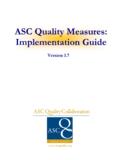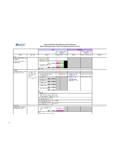Transcription of Boston University Activity Measure for Post Acute Care ...
1 Boston University Activity Measure for post Acute Care (AM-PAC). Instruction Manual AM-PAC Computerized Adaptive Testing AM-PAC CAT . Personal Computer Version Basic Mobility, Daily Activity and Applied Cognitive Functional Domains Developed by: Alan Jette, PT, PhD. Stephen M. Haley, PT, PhD. Wendy Coster, OT, PhD. Pengsheng Ni, MD, MPH. Boston University Health and Disability Research Institute Distributed by CREcare, LLC. Email: Website: AM-PAC Computerized Adaptive Testing (AM-PAC CAT). Manual Personal Computer Version Table of Contents Page Section 1: Introduction Activity Measure for post Acute Care (AM-PAC) .. 4. AM-PAC Computerized Adaptive Testing . 5. AM-PAC CAT Functional Domains 6. Section 2: AM-PAC CAT Software Hardware and Software Requirements 8. Downloading and Installing AM-PAC CAT Software . 8. Section 3: Administering the AM-PAC CAT.
2 Patient Demographic 11. AM-PAC CAT Questions-Respondent Instructions .. 13. Initial Evaluation . 14. Follow Up Evaluation .. 15. Section 4: AM-PAC CAT: Reports and Interpreting Scores View and Print Reports .. 17. Interpreting Basic Mobility Scores 18. Interpreting Daily Activity Scores .. 19. Interpreting Applied Cognitive Scores .. 20. Facility Reports: Aggregate Data . 21. Section 5: AM-PAC CAT Computer Versions Freestanding PC and Web/Server Versions 22. Section 6: References AM-PAC and AM-PAC CAT Annotated Bibliography .. 23. AM-PAC Computerized Adaptive Testing Manual 2. Personal Computer Version ( ). Last revision: 2/8/2007. 2007, Trustees for Boston University , under license to CREcare, LLC. All rights reserved. Acknowledgements Work to develop the Boston University Activity Measure for post Acute Care (AM-PAC) was undertaken at the Boston University Research and Training Center for Measuring Rehabilitation Outcomes and supported, in part, by the National Institute on Disability and Rehabilitation Research (grant no.)
3 H133B990005) and the National Institute of Child Health and Human Development (grant no. R01 HD43568). Development of the AM-PAC Outpatient Short Forms for use in outpatient settings was supported in part by an Independent Scientist Award (K01 HD45354-01) received by Stephen Haley, PhD. AM-PAC Computerized Adaptive Testing Manual 3. Personal Computer Version ( ). Last revision: 2/8/2007. 2007, Trustees for Boston University , under license to CREcare, LLC. All rights reserved. Section 1: Introduction Activity Measure for post Acute Care (AM-PAC) . The Boston University Activity Measure for post Acute Care (AM-PAC) is an Activity limitations instrument developed using the World Health Organization's International Classification of Functioning, Disability and Health (ICF). According to the ICF, an Activity limitation is defined as difficulty in the execution of a task or action by an individual.
4 1 The AM-PAC was developed as a functional outcomes system that can be used across post Acute care settings and consists of a comprehensive list of 240 functional activities ( , the item bank). It measures functional outcome by using contemporary measurement techniques, such as Item Response Theory (IRT), to overcome the limitations of traditional functional outcome measures (Jette and Haley, 2005). Unlike these traditional functional outcome measures which are disease, condition, or setting- specific, the AM-PAC was designed to be used across patient diagnoses, conditions and settings where post Acute care is being provided; therefore, the AM-PAC is the ideal Measure for developing benchmarks and for examining functional outcomes over an episode of post Acute care, as patients move across care settings. The AM-PAC instrument examines a set of functional activities that are likely to be encountered by most adults during daily routines within the context of either an inpatient episode of care or outpatient post Acute services.
5 We have defined functional Activity as the execution of discrete daily tasks. Because functional Activity is multidimensional, AM-PAC item banks are organized into three functional areas: Basic Mobility (101 items), Daily Activity (70 items), and Applied Cognitive (69 items). Items for the AM-PAC have been drawn from two sources: (1) a set of new items that examine the functional content domains listed above; and (2) items from existing outcome instruments used in rehabilitation and post Acute programs. The items in the AM-PAC assess multiple aspects ( , difficulty, assistance, limitations) of an individual's ability to perform specific daily activities. IRT analyses were used to scale individual items in different functional areas along a continuum of item difficulty. Initially, AM-PAC test items were administered to a large sample of patients from different care settings with different diagnoses.
6 Factor analytic work identified three distinct, interpretable factors that accounted for 72% of the variance: Applied Cognition (44%), Daily Activities (19%) and Basic Mobility (9%). These _____. 1. International Classification of Functioning, Disability and Health (ICF). Geneva, Switzerland: World Health Organization; 2001. AM-PAC Computerized Adaptive Testing Manual 4. Personal Computer Version ( ). Last revision: 2/8/2007. 2007, Trustees for Boston University , under license to CREcare, LLC. All rights reserved. factors were verified by a confirmatory factor analysis (Haley et al. 2004) and defined as the three AM-PAC domains. Using Item Response Theory (IRT), items in each domain were scaled along a continuum of item difficulty. Items that were redundant or did not fit the model were eliminated. The remaining items formed the AM-PAC item banks, which included a wide range of items calibrated along a continuum of difficulty.
7 The instrument can be administered using responses coming directly from a patient, by professional judgment, or proxy report. Three AM-PAC versions are currently available: 1) Outpatient short forms 2) A free-standing computer version 3) A Web-based computer version AM-PAC Computerized Adaptive Testing Computer Adaptive Testing (CAT) uses a computer algorithm to pre-select the items that will be administered to a specific patient based on responses to previous items. CAT-based instruments have the following advantages: They reduce test burden while increasing test precision because test items are selected to match the patient's functional ability level. Patients are not required to respond to irrelevant test items. It is easy to integrate assessment into clinical work flow. They promote efficient and reliable data entry, analysis and management.
8 AM-PAC data, along with patient data (age, gender, diagnosis, time since onset, surgical status, severity and insurance), are entered and stored in a database on the local computer or on a server. It only takes two minutes to complete each domain. They can include patient satisfaction questions. CAT is an outcome measurement approach designed for comprehensive and precise point-of-care assessment of patient-related outcomes. It is being used with increasing frequency in the health field. This method of patient assessment uses a computer to administer test items to patients and is adaptive in the sense that each test' is tailored to the unique level of each patient. Each person who takes an adaptive test is taking a different version of the test because the items are administered on the basis of the patient's previous responses.
9 By avoiding the administration of large number of questionnaire items and by selecting only those questions from a large item-bank' that provide the maximum amount of information based upon a person's responses to previous questions, CAT. approaches allow for efficient point-of-care collection of accurate outcome information that can feasibly be implemented in busy clinical and research settings. AM-PAC Computerized Adaptive Testing Manual 5. Personal Computer Version ( ). Last revision: 2/8/2007. 2007, Trustees for Boston University , under license to CREcare, LLC. All rights reserved. The computer-based versions of the AM-PAC assess the three domains in all post Acute settings (inpatient, outpatient and home care). AM-PAC CAT Functional Domains The AM-PAC Basic Mobility domain includes 101 items that address basic movement and physical functioning activities, such as bending, walking, carrying, and climbing stairs.
10 The AM-PAC Daily Activity domain includes 70 items that address basic self care and instrumental activities of daily life. The AM-PAC. Applied Cognitive domain includes 69 items that access higher level cognitive functions that are necessary to live independently. Listed below are examples of items from each of the AM-PAC domains. Basic Mobility Domain: How much DIFFICULTY do you (or the patient) currently have . moving from lying on your back to sitting on side of the bed getting up from the floor reaching overhead while standing, as if to pull a light cord using an escalator going up and down a flight of stairs inside, using a handrail walking around inside a building (50 ft, or 16 meters) on the same level going up and down three flights of stairs inside, using a handrail carrying something in both arms while climbing a flight of stairs ( , laundry basket climbing stairs step-over-step without a handrail (alternating feet).)





